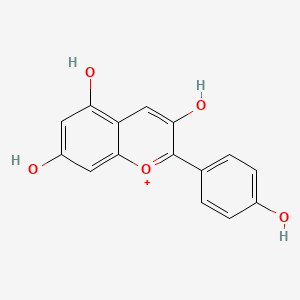| MeSH term | MeSH ID | Detail |
|---|---|---|
| Cystitis | D003556 | 23 associated lipids |
| Parkinsonian Disorders | D020734 | 20 associated lipids |
Pelargonidin
Pelargonidin is a lipid of Polyketides (PK) class. The involved functions are known as Uptake, Intestinal Absorption, glucose uptake, Process and Metabolic Inhibition. Pelargonidin often locates in Serosal, Mucous Membrane, brush border membrane, Membrane and Cell surface. The associated genes with Pelargonidin are SLC5A1 gene, SLC2A2 gene, Homologous Gene, F3 gene and CRSP3 gene. The related experimental models are Knock-out.
Cross Reference
Introduction
To understand associated biological information of Pelargonidin, we collected biological information of abnormalities, associated pathways, cellular/molecular locations, biological functions, related genes/proteins, lipids and common seen animal/experimental models with organized paragraphs from literatures.
What diseases are associated with Pelargonidin?
There are no associated biomedical information in the current reference collection.
Possible diseases from mapped MeSH terms on references
We collected disease MeSH terms mapped to the references associated with Pelargonidin
PubChem Associated disorders and diseases
What pathways are associated with Pelargonidin
There are no associated biomedical information in the current reference collection.
PubChem Biomolecular Interactions and Pathways
Link to PubChem Biomolecular Interactions and PathwaysWhat cellular locations are associated with Pelargonidin?
Visualization in cellular structure
Associated locations are in red color. Not associated locations are in black.
Related references are published most in these journals:
| Location | Cross reference | Weighted score | Related literatures |
|---|
What functions are associated with Pelargonidin?
Related references are published most in these journals:
| Function | Cross reference | Weighted score | Related literatures |
|---|
What lipids are associated with Pelargonidin?
There are no associated biomedical information in the current reference collection.
What genes are associated with Pelargonidin?
Related references are published most in these journals:
| Gene | Cross reference | Weighted score | Related literatures |
|---|
What common seen animal models are associated with Pelargonidin?
Knock-out
Knock-out are used in the study 'MATE2 mediates vacuolar sequestration of flavonoid glycosides and glycoside malonates in Medicago truncatula.' (Zhao J et al., 2011).
Related references are published most in these journals:
| Model | Cross reference | Weighted score | Related literatures |
|---|
NCBI Entrez Crosslinks
All references with Pelargonidin
Download all related citations| Authors | Title | Published | Journal | PubMed Link |
|---|---|---|---|---|
| Estévez L and Mosquera RA | Conformational and substitution effects on the electron distribution in a series of anthocyanidins. | 2009 | J Phys Chem A | pmid:19685919 |
| Choi JG et al. | In Vitro and In Vivo Antibacterial Activity of Punica granatum Peel Ethanol Extract against Salmonella. | 2011 | Evid Based Complement Alternat Med | pmid:19687188 |
| Jung CS et al. | The potato developer (D) locus encodes an R2R3 MYB transcription factor that regulates expression of multiple anthocyanin structural genes in tuber skin. | 2009 | Theor. Appl. Genet. | pmid:19779693 |
| Dreiseitel A et al. | Berry anthocyanins and anthocyanidins exhibit distinct affinities for the efflux transporters BCRP and MDR1. | 2009 | Br. J. Pharmacol. | pmid:19922539 |
| Morant M et al. | Metabolomic, transcriptional, hormonal, and signaling cross-talk in superroot2. | 2010 | Mol Plant | pmid:20008451 |
| Gargouri M et al. | The epimerase activity of anthocyanidin reductase from Vitis vinifera and its regiospecific hydride transfers. | Biol. Chem. | pmid:20030585 | |
| BuendÃa B et al. | HPLC-MS analysis of proanthocyanidin oligomers and other phenolics in 15 strawberry cultivars. | 2010 | J. Agric. Food Chem. | pmid:20038100 |
| Korte G et al. | An examination of anthocyanins' and anthocyanidins' affinity for cannabinoid receptors. | 2009 | J Med Food | pmid:20041802 |
| Tanaka Y et al. | Recent progress of flower colour modification by biotechnology. | 2009 | Int J Mol Sci | pmid:20054474 |
| Li X et al. | Purple canola: Arabidopsis PAP1 increases antioxidants and phenolics in Brassica napus leaves. | 2010 | J. Agric. Food Chem. | pmid:20073469 |
